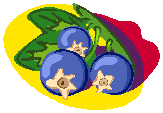

Welcome to
Blueberry Chef
- Recipes for Blueberries.
 |
|
Welcome to |
|---|
|
Growing Blueberries There are two main groups of blueberries, lowland blueberries which include the bilberries or whinberries and the better known blueberries.The other group the highland berries are self- pollinating, but will bear more fruit if they are grown with other varieties. For maximum crops at least two varieties should be planted together. There are some differences between the two plants, but essentially the berries are the same. To obtain blueberry plants, you can either propagate from cuttings that are taken in the spring or buy as plants in containers or as bare rooted plants. Take 10-15 cm (4-6 in) of softwood cuttings in late spring from the tips of the current seasons growth, or instead you can take hardwood cuttings during the dormant season after sufficient chilling has occurred which is usually in mid- to late winter. Even though blueberries are hardy in any sunny, open site, they should not be exposed to strong winds. They require a very acidic soil, with a pH of 5.0-5.5, and the soil should be consistently moist but never water logged. It should not be too rich in nutrients before planting. Prior to planting, cut plants back to a height of 15-30 cm (6-12 in) or remove at least 50 % of the top^, including all flower buds. You must not allow newly set plants to flower or set the first year. Try to set the plants at the same depth as when they were grown at the nursery or 1 cm (1/2 in) deeper and mulch well with a well rotted manure or compost. Blueberries are a freestanding bush, so you will not need to support or train them to grow in a certain way. They do not need to be fed a lot, but an annual application of about 100 g (4 oz) of fish, blood and bone and an annual mulch in the late winter will give you good growth. Water blueberries once per week using about 2.5-5.0 cm (1-2 in) of water. In order to have good fruit set, blueberries need cross-pollination between different varieties and two or more of the same varieties should be planted close by each other. Efforts should be made to attract insects especially honeybees and wild bees so that pollination of the plants can occur. When a few years have passed after planting the blueberries remove the tips of the plants in the autumn and as the bush gets larger, cut out any dead, weak or damaged growth so that you can ensure a free air supply between each branch. It is best to pick blueberries when they are ripe, which is usually ten days after they have turned blue. They do not store well, and should be used immediately, but can be frozen. When diseases do occur they are limited mainly to mildew and botrytis, and you may have the occasional outbreak of aphids. You will find birds are a more common problem and you may need a netting to protect them. http://www.wolverineonlinesales.com |
|
|---|

Custom Search
|
Contact Us Copyright 2010 ©Linda C Butler PO Box 92, Chilliwack BC V2P 6H7 All Rights Reserved Internationally Legal Notice and Privacy Policy |
|---|